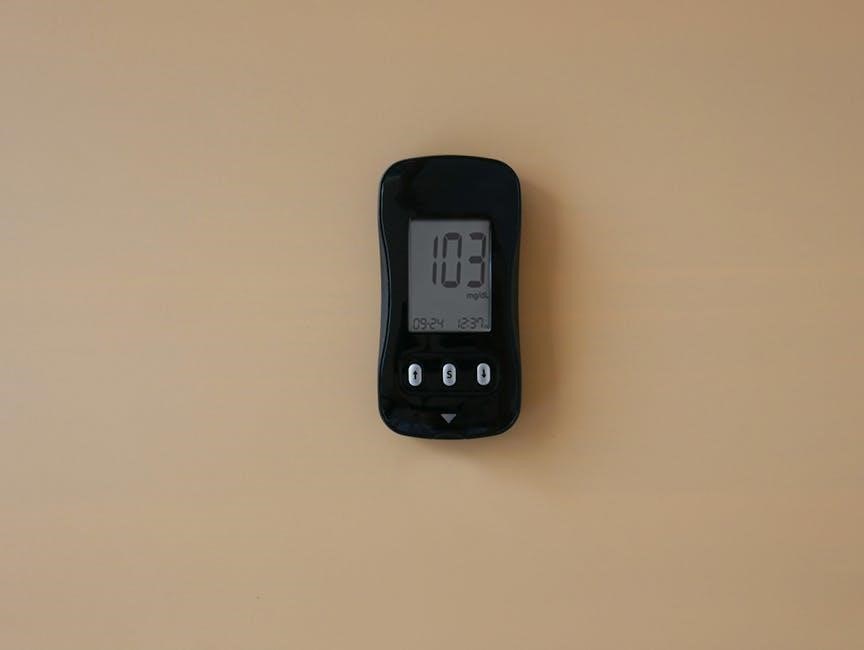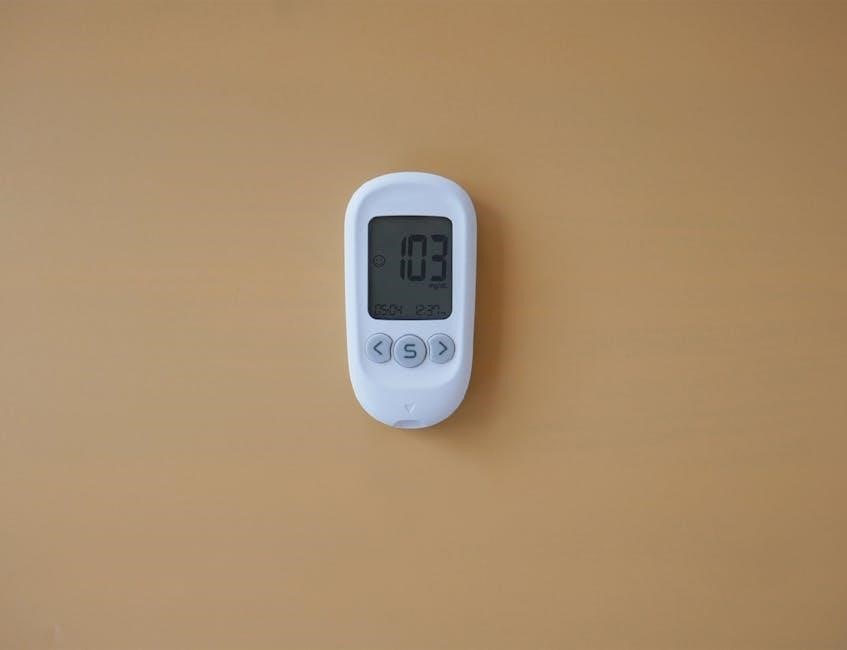A gestational diabetes log sheet is a vital tool for monitoring blood sugar levels, meals, and exercise during pregnancy. It helps track progress, identify patterns, and make informed decisions to ensure a healthy pregnancy and baby. Regular use supports better glucose control and communication with healthcare providers.

What is Gestational Diabetes?
Gestational diabetes is a type of diabetes that develops during pregnancy, typically in the second or third trimester. It occurs when the body’s insulin production cannot keep up with the increased insulin resistance caused by hormonal changes and the growing placenta. This results in high blood sugar levels, which can pose risks to both the mother and the baby if left unmanaged.
Unlike type 1 or type 2 diabetes, gestational diabetes is specifically related to pregnancy and usually goes away after childbirth. However, it can increase the likelihood of developing type 2 diabetes later in life for both the mother and the child. Symptoms may be mild or absent, but common signs include increased thirst, frequent urination, and fatigue.

Managing gestational diabetes is crucial to prevent complications such as preeclampsia, premature birth, or delivering a large baby. Healthcare providers often recommend lifestyle changes, including a balanced diet, regular physical activity, and monitoring blood sugar levels. A gestational diabetes log sheet is a valuable tool for tracking these metrics and ensuring the health of both the mother and the baby throughout the pregnancy.

Importance of Monitoring Blood Sugar
Monitoring blood sugar levels is essential for managing gestational diabetes and ensuring the health of both the mother and the baby. High blood sugar levels, if left uncontrolled, can lead to complications such as preeclampsia, premature birth, or delivering a large baby. By tracking blood sugar, individuals can identify patterns and make necessary adjustments to their diet, exercise, and lifestyle to maintain target levels.
Target blood sugar levels during pregnancy are typically set at specific ranges, such as fasting levels below 5.3 mmol/L and postprandial levels below 6.7 mmol/L. Regular monitoring helps prevent hyperglycemia, which can increase the risk of complications. Additionally, tracking blood sugar levels provides valuable insights into how different foods, physical activity, and stress affect glucose levels, enabling better decision-making.
Consistency in monitoring is key, as it allows healthcare providers to assess the effectiveness of the current management plan and make adjustments as needed. A gestational diabetes log sheet is a practical tool for recording these measurements, ensuring that all relevant data is organized and easily accessible for both the individual and their healthcare team.
Benefits of Using a Log Sheet
A gestational diabetes log sheet offers numerous benefits for effectively managing the condition. It provides a structured way to track blood sugar levels, meals, exercise, and other factors that influence glucose control. By documenting daily activities and measurements, individuals can identify patterns and make informed decisions to maintain healthy blood sugar levels.
Using a log sheet ensures accountability and consistency in monitoring, which is crucial for managing gestational diabetes. It also serves as a valuable tool for healthcare providers, allowing them to assess progress and adjust treatment plans as needed. The log sheet simplifies the process of recording and analyzing data, making it easier to understand how different factors impact blood sugar levels.
Additionally, a log sheet can be customized to include specific details such as meal plans, carbohydrate intake, and physical activity. This personalized approach helps individuals stay organized and focused on their health goals. Overall, a gestational diabetes log sheet is an essential resource for achieving better glucose control and ensuring a healthy pregnancy outcome.

Key Components of a Log Sheet
A gestational diabetes log sheet typically includes date, time, blood sugar levels, meals, carbohydrate intake, exercise, and notes. These components help track glucose trends, meal impacts, and overall health management effectively.
Date and Time
Recording the date and time is essential for accurate tracking in a gestational diabetes log sheet. This helps monitor blood sugar levels, meal intake, and exercise at specific moments, providing a clear timeline of daily activities. By noting the date, individuals can observe trends over weeks, while time stamps allow for precise correlation between actions (like eating or testing blood sugar) and their effects. Consistent logging enables healthcare providers to identify patterns and make informed decisions. For example, tracking fasting blood sugar in the morning and postprandial levels after meals helps assess how different foods impact glucose levels. This detailed documentation also aids in adjusting diets or exercise routines as needed. Many log sheets include columns for both date and time, ensuring organized and easy-to-review data. Regularly updating this information fosters accountability and better health outcomes, making it a cornerstone of effective gestational diabetes management.

Blood Sugar Levels
Tracking blood sugar levels is a critical component of managing gestational diabetes. A log sheet provides a structured way to record fasting and postprandial glucose readings, ensuring consistent monitoring. Target ranges, such as fasting blood sugar below 5.3 mmol/L and 2-hour postprandial levels below 6.7 mmol/L, are often included for reference. By documenting these values, individuals can identify patterns and trends, helping to refine their dietary and exercise routines. Many log sheets also allow space for noting the time of testing, which is essential for correlating blood sugar levels with meals and activities. This detailed tracking not only aids in maintaining tight glucose control but also provides valuable data for healthcare providers to adjust treatment plans. Consistency in recording blood sugar levels is key, as it helps prevent complications and supports a healthy pregnancy outcome. Over time, this data becomes a powerful tool for managing gestational diabetes effectively and ensuring the well-being of both mother and baby.
Meals and Carbohydrate Intake

Tracking meals and carbohydrate intake is essential for managing gestational diabetes, as carbs directly impact blood sugar levels. A log sheet allows individuals to document each meal, including portion sizes, carbohydrate counts, and the timing of consumption. This helps identify how specific foods affect blood sugar levels and supports better dietary choices. Many log sheets provide space to record breakfast, lunch, dinner, and snacks, along with the corresponding carbohydrate content. This detailed tracking enables individuals to balance their diet and maintain stable glucose levels. Additionally, noting the glycemic index of foods can help differentiate between high and low glycemic options, aiding in meal planning. By monitoring meals and carbs, individuals can identify patterns and make adjustments to prevent blood sugar spikes. This section of the log sheet also serves as a tool for healthcare providers to offer personalized dietary advice. Consistent tracking of meals and carbs is crucial for achieving and maintaining glucose control, ultimately supporting a healthy pregnancy and reducing the risk of complications. Over time, this data helps create a tailored meal plan that aligns with individual needs and promotes overall well-being.
How to Use the Log Sheet Effectively
Consistently record blood sugar levels, meals, and exercise to identify patterns and make informed decisions. Review the data regularly with your healthcare provider to adjust your plan and achieve better glucose control for a healthy pregnancy outcome.
When to Test Blood Sugar
Testing blood sugar levels at specific times is crucial for managing gestational diabetes. Typically, women are advised to test four times daily: fasting (first thing in the morning), and 2 hours after the start of breakfast, lunch, and dinner. Consistency in testing times helps identify patterns and ensures accurate tracking. For example, fasting blood sugar should be below 5.3 mmol/L, while 2 hours after meals, it should be below 6.7 mmol/L. Recording these readings in your log sheet provides valuable insights for adjusting meals, exercise, and medications. Regular monitoring also helps prevent complications and ensures the health of both mother and baby. By maintaining a consistent testing schedule and documenting results, you can better understand how different factors affect your blood sugar levels, enabling informed decisions and effective management of gestational diabetes.
Tracking Meals and Exercise
Tracking meals and exercise is a cornerstone of managing gestational diabetes. By documenting everything you eat and drink, including portion sizes and macronutrient breakdowns, you can identify how specific foods affect your blood sugar levels. This helps in making informed dietary choices to maintain stable glucose levels. Additionally, recording physical activity, such as the type, duration, and intensity of exercise, provides insights into how movement impacts your blood sugar. Many log sheets include sections for noting water intake, stress levels, and sleep patterns, as these factors also influence glucose control. By consistently tracking these elements, you can identify patterns and make adjustments to your daily routine. For example, if a particular meal consistently causes high blood sugar, you can modify your diet accordingly. Similarly, understanding how exercise lowers glucose levels can help you incorporate more physical activity into your schedule. This comprehensive approach ensures that you and your healthcare provider can work together to optimize your care and maintain a healthy pregnancy. Regular tracking also fosters accountability and helps in achieving long-term glucose management goals.

Downloadable Gestational Diabetes Log Sheet PDF Templates
Downloadable gestational diabetes log sheet PDF templates are readily available online, offering customizable and printable designs. These templates include sections for blood sugar levels, meals, exercise, and notes, making it easy to track and manage your health effectively during pregnancy.
Where to Find Templates
Gestational diabetes log sheet PDF templates are widely available online, offering convenience and accessibility. Websites like thegestationaldiabetic.com provide downloadable and printable templates designed specifically for tracking blood sugar, meals, and exercise. Additionally, platforms like Etsy and Amazon offer a variety of customizable templates, ranging from daily to monthly logs. Many of these templates are free, while others require a small purchase. Healthcare providers may also offer their own versions, tailored to individual needs. Some templates are editable, allowing users to personalize sections for meals, snacks, and notes. These resources make it easy to find a log sheet that fits your lifestyle and preferences, ensuring effective monitoring and management of gestational diabetes. By downloading a template, you can start tracking your health journey seamlessly and maintain clear communication with your healthcare team.

Comparing Different Types of Log Sheets
Daily and monthly log sheets cater to different needs. Daily logs offer detailed tracking of meals, blood sugar, and exercise, while monthly logs provide a broader overview of trends and patterns over time. Both options are available as customizable templates online.
Daily vs. Monthly Logs
Daily and monthly log sheets serve different purposes in managing gestational diabetes. Daily logs provide detailed, real-time tracking of blood sugar levels, meals, and exercise, allowing for immediate insights and adjustments. They are ideal for identifying specific patterns, such as how certain foods or activities affect blood glucose levels. Monthly logs, while less detailed, offer a broader overview of trends and progress over time. They are useful for spotting long-term patterns and are often more convenient for those who prefer a less intensive tracking method. Both types are available as downloadable PDF templates, making them easily accessible and customizable. Daily logs are preferred by individuals who need precise monitoring, while monthly logs suit those who want a simpler, high-level view. Ultimately, the choice depends on personal preference and the level of detail required for effective blood sugar management. Both tools are essential for maintaining control and ensuring a healthy pregnancy. They help individuals and healthcare providers make informed decisions and adjustments as needed.
Best Practices for Maintaining a Log Sheet
Consistency is key to effectively managing gestational diabetes. Track blood sugar levels, meals, and exercise regularly. Record accurate and detailed information to identify patterns and make informed decisions. Review your log with healthcare providers to refine your care plan and ensure optimal outcomes.
Consistency is Key
Consistency is crucial when maintaining a gestational diabetes log sheet. Regularly tracking blood sugar levels, meals, and exercise ensures accurate data collection, helping identify patterns and trends. This consistency allows for better glucose control and informed decision-making. By logging information daily, you can monitor progress and adjust your diet or exercise routine as needed. Consistent tracking also aids healthcare providers in understanding your condition and providing personalized advice. Over time, this habit helps maintain healthy blood sugar levels, reducing risks to both mother and baby. Make logging a part of your daily routine to ensure comprehensive and reliable data. This consistent effort supports a healthier pregnancy and better overall management of gestational diabetes.
Managing Gestational Diabetes Through Diet and Exercise
Managing gestational diabetes through diet and exercise is essential for blood sugar control. Focus on balanced meals, portion control, and regular physical activity. Tracking these elements in a log sheet helps maintain a healthy pregnancy and overall well-being.
Dietary Considerations
Managing gestational diabetes through diet is crucial for maintaining stable blood sugar levels. Focus on balanced meals rich in whole foods, such as lean proteins, whole grains, and non-starchy vegetables. Avoid sugary drinks and refined carbohydrates, which can spike blood sugar. Portion control is key, as overeating can lead to elevated glucose levels. Incorporate low-glycemic foods like whole grains, legumes, and most fruits and vegetables, which digest slowly and prevent sharp blood sugar spikes. Healthy fats, such as avocados and nuts, can also help regulate blood sugar. Stay hydrated by drinking plenty of water throughout the day. Tracking meals and their impact on blood sugar levels in a log sheet can help identify patterns and make informed dietary adjustments. Consulting a registered dietitian or healthcare provider can provide personalized meal plans tailored to individual needs. By adhering to these dietary guidelines, women with gestational diabetes can better manage their condition and support a healthy pregnancy. Regular monitoring and adjustments ensure optimal glucose control and overall well-being.
Using a gestational diabetes log sheet is a powerful way to take control of blood sugar management during pregnancy. By tracking meals, exercise, and glucose levels, women can identify patterns and make informed decisions to maintain stable blood sugar levels. This tool not only helps prevent complications but also supports a healthy pregnancy and baby. Consistent use of a log sheet, combined with a balanced diet and regular physical activity, can significantly improve overall health outcomes. Additionally, sharing the log with healthcare providers ensures personalized care and guidance. With the availability of downloadable PDF templates, it’s easier than ever to start monitoring and managing gestational diabetes effectively. By staying committed to tracking and maintaining a healthy lifestyle, women can navigate their pregnancy with confidence and ensure the best possible results for themselves and their baby.

